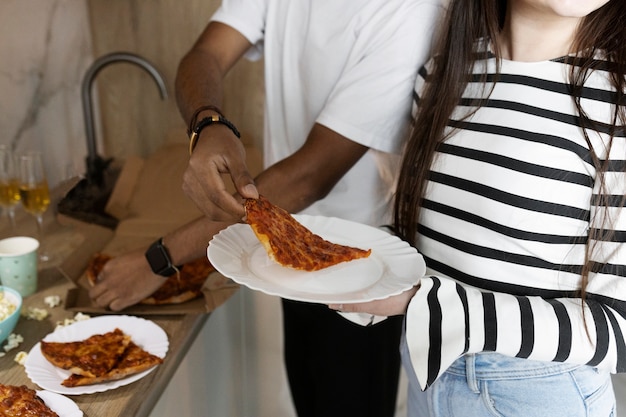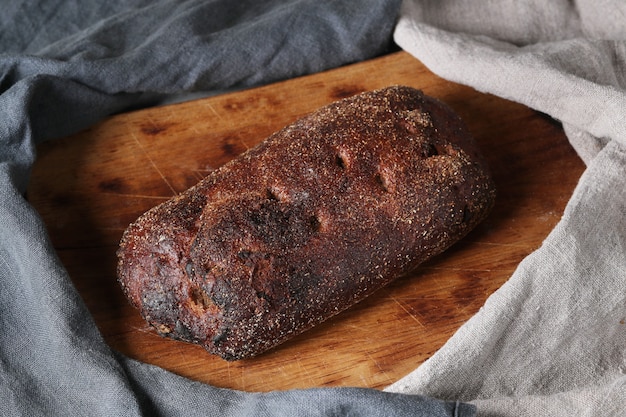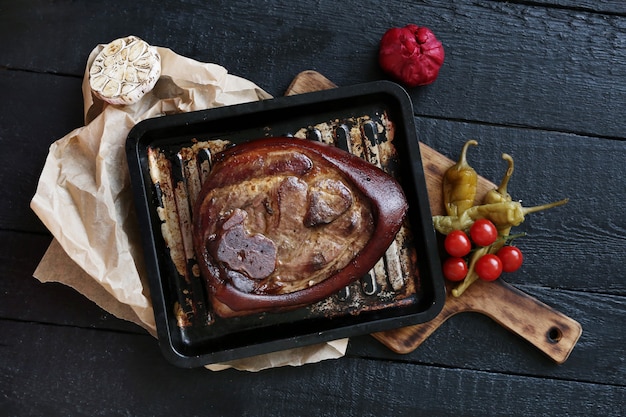Ah, meatloaf. A humble dish that conjures up images of warm, comforting meals and family gatherings. But let’s be honest, baking the perfect loaf can feel like a culinary tightrope walk. One wrong move, and you're left with a dry, crumbly disaster. Or worse, an undercooked, potentially unsafe mess.
Over the years, I’ve learned that mastering the art of meatloaf cooking time is about more than just a simple timer. It’s about understanding the intricate relationship between heat, ingredients, and the delicate process of baking. It's about respecting the science and embracing the creativity that goes into crafting a truly magnificent meatloaf.
(Part 1) The Meatloaf Masterclass: Embracing the Basics

The Temperature Tango: It’s All About the Heat
Listen, I know you've probably heard this a million times, but it bears repeating: temperature is king. We're not talking about the weather here, but the internal temperature of your meatloaf. It's the key to a safe and delicious meal. The golden rule, friends, is 160°F (71°C).
Think of it this way: your oven is like a backstage crew, carefully controlling the spotlight on your culinary star – the meatloaf. Just like a performer needs the right lighting, your meatloaf needs the right temperature to reach its full potential. That perfect temperature guarantees the meat is cooked through and safe to eat.
Unveiling the Meatloaf Formula: Ingredients Matter
Before we dive into the intricacies of cooking time, let’s lay down the foundation – the ingredients that make up a classic meatloaf. You see, a good meatloaf isn't just about the meat. It’s about the symphony of flavours and textures that come together in perfect harmony.
- Meat: It's the star of the show! We're talking about a mix of ground beef, pork, and veal for a richer, more complex flavour. But don't be afraid to go solo with just ground beef or turkey if you prefer a leaner option.
- Binders: These are the glue that holds the meatloaf together, ensuring it maintains its shape and structure during cooking. Think of eggs and breadcrumbs as the unsung heroes in this scenario.
- Flavour Enhancers: Now, here's where you get to have some fun! Onions, garlic, herbs, spices, even vegetables – they all play a part in creating a delicious and unique taste profile. Personally, I'm a fan of fresh parsley, garlic powder, onion powder, and a touch of paprika for a bright and aromatic punch.
- Liquid: This is like the magic ingredient that adds moisture and richness to your meatloaf. It can be milk, broth, tomato sauce, even beer! The choice is yours, but remember, liquid plays a vital role in achieving that perfect texture.
These ingredients form the backbone of a good meatloaf. Feel free to experiment, swap in different combinations, and even add your own personal touch. That's the beauty of this dish – it's yours to personalise.
(Part 2) The meatloaf cooking time Conundrum: Decoding the Variables

Size Matters: Finding the Right Fit for Your Loaf
Let's face it, there's no one-size-fits-all approach when it comes to meatloaf. The size of your loaf plays a crucial role in determining cooking time. A smaller loaf will naturally cook faster than a larger one. So, before we even think about preheating the oven, we need to know how big your culinary creation will be.
My go-to is a standard 2lb (900g) loaf, perfect for a family dinner. But if you're feeding a crowd, go for a larger loaf, like 3lb (1.3kg) or even 4lb (1.8kg). Don't worry, we’ll figure out the perfect cooking time together, no matter the size.
Shape and Form: A Matter of Style and Strategy
The shape of your meatloaf also plays a part in the cooking equation. A round loaf cooks more evenly than a loaf with a more intricate shape, like a crown or a star. It's all about heat distribution!
Personally, I prefer a classic rectangular loaf. It's simple, elegant, and easy to slice. But if you're feeling adventurous, explore those more elaborate shapes. Just remember to adjust the cooking time accordingly.
(Part 3) Understanding the Oven’s Role: The Maestro of meatloaf baking

The Importance of Preheating: Setting the Stage for Success
You've got your ingredients prepped, your loaf is shaped, and you're ready to bake. But hold on! Don’t just toss your meatloaf into a cold oven. Preheating is crucial.
I always preheat my oven to 350°F (175°C) for at least 15 minutes before even thinking about putting the meatloaf in. It's like preparing the stage for a performance. By preheating, you’re creating a consistent heat environment that allows the meatloaf to cook evenly. Think of it as creating the perfect culinary spotlight for your masterpiece.
Baking Like a Pro: The Art of Patience and Precision
Now, here’s where the real work begins. The average baking time for a 2lb (900g) meatloaf is 45-60 minutes. But remember, this is just a guide. Don’t simply set a timer and walk away. You need to keep a watchful eye and make adjustments as needed.
Invest in a meat thermometer. It's your culinary compass, guiding you to that perfect 160°F (71°C) in the thickest part of the loaf. Once you hit that target, you're good to go!
If you’re not using a thermometer, check the doneness by inserting a fork into the center of the loaf. If the juices run clear, it’s cooked through. If they’re still pink, it needs a few more minutes in the oven.
(Part 4) The Meatloaf Rest: A Time for Relaxation and Reinvention
Allow the Loaf to Rest: A Crucial Step in the Culinary Process
Now, here’s a secret you might not know. After you take your meatloaf out of the oven, don’t rush to slice it. Let it rest for 10-15 minutes before carving it up. This allows the juices to redistribute throughout the loaf, resulting in a more tender and juicy meatloaf.
Imagine it as a little break for your meatloaf, a moment to relax and recover after its time in the oven. Just like you need to unwind after a workout, your meatloaf needs time to settle in before you dive into those delicious slices.
(Part 5) The Meatloaf Companion: Pairing Perfection
mashed potatoes: The Classic side dish Symphony
What's a meatloaf without a side of mashed potatoes? It's a classic pairing for a reason. The creamy, buttery texture of mashed potatoes complements the savory richness of meatloaf beautifully. They create a harmonious blend of flavours and textures that elevate the meal.
I love to add a touch of garlic and fresh herbs to my mashed potatoes for extra flavour. If you’re feeling indulgent, a dollop of sour cream or whipped cream on top is always a delightful treat.
green beans: A Healthy and Refreshing Counterpoint
To balance out the richness of the meatloaf and potatoes, I always serve a side of green beans. They add a healthy and refreshing element to the plate, creating a beautiful contrast in both taste and colour.
I love to roast green beans with a little olive oil, salt, and pepper. The slight char adds a nice smoky flavour that complements the meatloaf beautifully.
Gravy: The Finishing Touch, a Symphony of Flavour
No meatloaf is complete without a generous serving of gravy. It’s the finishing touch that brings all the flavours together, creating a symphony of savoury delight.
Making your own gravy from scratch, using the pan drippings from the meatloaf, is a truly rewarding experience. But if you're short on time, a good quality store-bought gravy will do the trick. Just make sure it's thick and flavorful!
(Part 6) meatloaf variations: Get Creative in the Kitchen
The Meatloaf Experiment: Adding Your Own Twist
Don’t be afraid to experiment with different flavours and ingredients. Meatloaf is a blank canvas, waiting for your creative touch.
Here are a few ideas to get you started:
- Cheesy Meatloaf: Add shredded cheese to the meatloaf mixture for a gooey, cheesy center. My go-to is cheddar cheese, but you can use mozzarella, parmesan, or even a blend of different cheeses. The cheese adds a delightful gooey texture and a rich, savoury flavour.
- Spicy Meatloaf: Spice things up with a touch of hot sauce, cayenne pepper, or chili powder. A little heat can add a welcome kick to the classic meatloaf profile.
- Veggie Meatloaf: Incorporate chopped vegetables like carrots, zucchini, or mushrooms into the meatloaf mixture for added nutrients and flavour. Adding vegetables not only adds a burst of color and texture but also contributes to a healthier and more balanced meal.
- Mediterranean Meatloaf: For a Mediterranean twist, add chopped olives, sun-dried tomatoes, and oregano to the meatloaf mixture. These ingredients create a delightful combination of salty, tangy, and aromatic notes, bringing a touch of the Mediterranean to your kitchen.
The possibilities are endless! So go ahead and experiment with different flavors and ingredients to create your own unique meatloaf masterpiece. The only limit is your imagination!
(Part 7) Meatloaf and Your Dietary Needs: Adjusting the Recipe for Everyone
The Meatloaf Makeover: Adapting for Dietary Preferences and Restrictions
Meatloaf is a dish that can be tailored to suit a wide range of dietary needs. You can adapt it to fit your lifestyle without sacrificing the deliciousness.
If you’re vegetarian or vegan, you can easily make a meatloaf using lentils, beans, or vegetables as a base. These ingredients provide a hearty and protein-rich foundation for your meatless loaf.
If you’re following a low-carb diet, you can use almond flour or coconut flour instead of breadcrumbs. These alternative flours provide the binding properties of breadcrumbs while keeping your carbohydrate intake low.
And if you’re looking for a healthier option, you can use ground turkey or chicken instead of ground beef. These leaner proteins offer a lighter alternative while still providing the delicious flavor of meatloaf.
Don't be afraid to adjust the recipe to suit your taste and lifestyle. The beauty of meatloaf is that it's incredibly adaptable.
(Part 8) The meatloaf leftovers: A Culinary Treasure Trove
The Leftover Magic: Delicious Second Helpings and Beyond
Let's be honest, meatloaf is so good that you’re bound to have leftovers. But don’t let them go to waste! Leftover meatloaf can be transformed into a delicious second meal or even a collection of mouthwatering snacks.
Here are a few ideas for using up leftover meatloaf:
- Meatloaf Sandwiches: Slice the leftover meatloaf and serve it on toasted bread with your favorite toppings, like cheese, lettuce, and tomato. The combination of savory meatloaf and fresh toppings creates a classic sandwich that is both satisfying and delicious.
- Meatloaf Salad: Dice the leftover meatloaf and add it to a salad with greens, vegetables, and a vinaigrette dressing. This is a great way to add protein and flavor to your salad, making it a more substantial meal.
- Meatloaf Soup: Chop the leftover meatloaf and add it to a hearty soup. Adding leftover meatloaf to soup adds a savory depth of flavour and a satisfying texture.
- Meatloaf Shepherd’s Pie: Layer leftover meatloaf with mashed potatoes and bake it in the oven for a comforting and delicious meal. This is a classic combination that is perfect for a cozy evening.
So, don’t think of leftovers as a chore. Think of them as an opportunity to create a delicious and satisfying new dish. Get creative and explore the possibilities!
(Part 9) The meatloaf recipe: A Step-by-Step Guide to Baking Perfection
The perfect meatloaf recipe: A culinary journey
Now, let’s get to the heart of the matter. Here’s my go-to recipe for a classic meatloaf that is guaranteed to please everyone.
Ingredients:
- 1 lb (450g) ground beef
- 1/2 lb (225g) ground pork
- 1/2 cup (120ml) bread crumbs
- 1/2 cup (120ml) milk
- 1 egg
- 1/2 cup (120ml) chopped onion
- 2 cloves garlic, minced
- 1 tablespoon Worcestershire sauce
- 1 teaspoon salt
- 1/2 teaspoon black pepper
- 1/4 teaspoon dried thyme
- 1/4 teaspoon dried oregano
- 1/4 cup (60ml) tomato ketchup
Instructions:
- Preheat oven to 350°F (175°C).
- In a large bowl, combine the ground beef, ground pork, bread crumbs, milk, egg, onion, garlic, Worcestershire sauce, salt, pepper, thyme, and oregano.
- Mix well until all ingredients are evenly combined.
- Shape the mixture into a loaf and place it on a baking sheet lined with parchment paper.
- Spread the tomato ketchup evenly over the top of the loaf.
- Bake for 45-60 minutes, or until the internal temperature reaches 160°F (71°C).
- Let the meatloaf rest for 10-15 minutes before slicing and serving.
Meatloaf Cooking Time Chart: A Guide for Every Loaf
Here’s a handy chart to help you figure out the cooking time for your meatloaf, based on its weight:
| Weight of Meatloaf | Cooking Time |
|---|---|
| 2lb (900g) | 45-60 minutes |
| 3lb (1.3kg) | 60-75 minutes |
| 4lb (1.8kg) | 75-90 minutes |
Remember, these are just guidelines. The actual cooking time may vary depending on your oven and the size and shape of your meatloaf. Always check the internal temperature with a meat thermometer to ensure it’s cooked through.
(Part 10) meatloaf faqs: Answers to Your Baking Questions
What happens if my meatloaf is overcooked?
If your meatloaf is overcooked, it will be dry and crumbly. To prevent this, make sure you don’t overbake it. Check the internal temperature with a meat thermometer and remove the meatloaf from the oven when it reaches 160°F (71°C). If you notice the loaf starting to brown too quickly, you can tent it with foil to prevent further browning.
What happens if my meatloaf is undercooked?
If your meatloaf is undercooked, it can be dangerous to eat. Always cook your meatloaf to an internal temperature of 160°F (71°C). If you’re unsure, it’s better to err on the side of caution and cook it for a few more minutes.
Can I freeze leftover meatloaf?
Yes, you can freeze leftover meatloaf. Wrap it tightly in plastic wrap and store it in the freezer for up to 3 months. To thaw it, place it in the refrigerator overnight.
How do I make a moist meatloaf?
The key to a moist meatloaf is to use a combination of binders and liquids. Bread crumbs and milk help to absorb excess moisture and keep the meatloaf from drying out. You can also use other liquids, such as broth, tomato sauce, or beer, to add flavor and moisture.
What are some tips for making a delicious meatloaf?
Here are a few tips for making a delicious meatloaf:
- Don’t overmix the ingredients. This can make the meatloaf tough.
- Use fresh, high-quality ingredients. This is the foundation of a flavorful and satisfying dish.
- Add a touch of flavor with herbs and spices. Experiment with different combinations to create your own unique flavour profile.
- Let the meatloaf rest for 10-15 minutes before slicing. This allows the juices to redistribute and results in a more tender and juicy meatloaf.
Now you have all the knowledge to bake a truly delicious meatloaf! So get into the kitchen and have fun creating your own culinary masterpiece. The journey to baking the perfect meatloaf starts with a little knowledge and a whole lot of passion.
Everyone is watching

How to Cook Frozen Lobster Tails Perfectly: A Step-by-Step Guide
RecipesLobster. Just the word conjures up images of lavish meals, special occasions, and a taste of luxury. But let's...

Pigs in a Blanket Cooking Time: How Long to Bake for Perfect Results
RecipesAh, pigs in a blanket. Just the name conjures up images of those delightful little parcels of crispy pastry en...

Pork Fillet Cooking Time: How Long to Cook It Perfectly
RecipesPork fillet, or tenderloin as it's sometimes called, is a real favourite in our house. It's so versatile, and...

The Ultimate Guide to Cooking Delicious Frankfurters
RecipesLet's face it, we all love a good frankfurter. It's a classic, simple, and always satisfying. But let's be rea...

The Ultimate Guide to Tender, Juicy Pulled Pork
RecipesRight, let's talk pulled pork. It's one of those dishes that just screams "comfort food," doesn't it? I mean...
